Industry Surrounds Newark’s Ironbound Neighborhood—But These Residents Won’t Let It Define Them
The tireless efforts of locals are reshaping one of New Jersey’s most polluted areas.
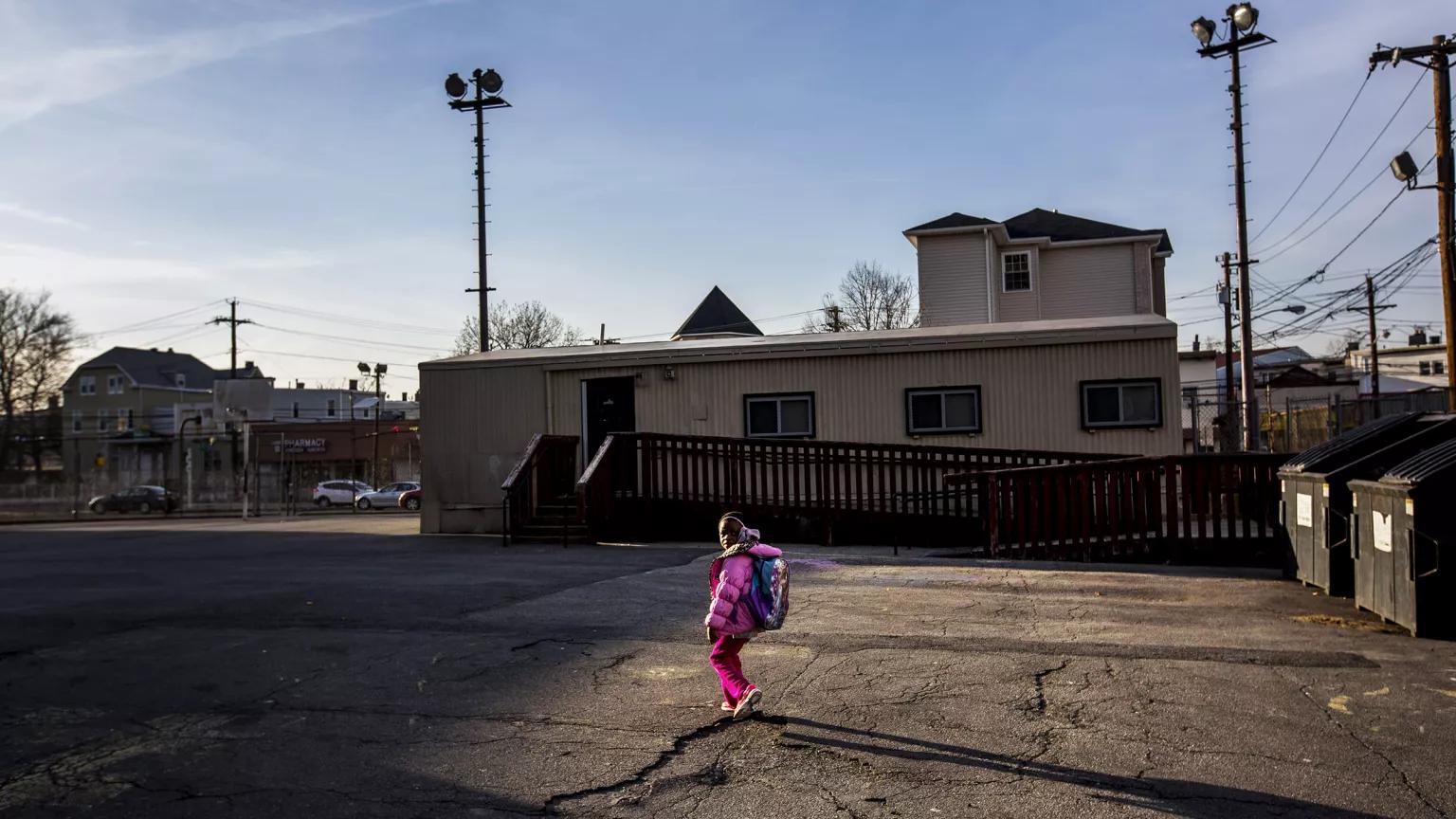
Six-year-old Faith Garner walking to school through a parking lot in New Jersey's Ironbound neighborhood
Natalie Keyssar
Even when speeding along by train or car, people traveling through Newark, New Jersey, know it by their noses. “No one expects New Jersey, especially North Jersey, to smell good,” says Newark resident and activist Melissa Miles, only half jokingly. “You know, certain aspects of life here, like a huge tower belching smoke—it’s just part of the landscape.”
Whether it’s trash trucked in from New York City or brand-new goods on a container ship from Shanghai, consumer material in all phases of its life cycle comes to Newark—through its international airport or enormous port, its countless warehouses, or the trash incinerator that burns nearly a million tons of garbage each year. Meanwhile, within the tangle of highways, railways, runways, and seaports that make up the infrastructure backbone of the greater Northeast live the residents of the city’s Ironbound neighborhood. Surrounded by much of Newark’s heavy industry, many in the community—which is predominantly composed of immigrants (and their descendants) from Portugal, Brazil and Latin America, as well as African Americans—struggle to breathe.
Miles lived in the Ironbound for a decade before she started to recognize its environmental issues. In 2013, her oldest son, then just a year old, was diagnosed with asthma—a condition that affects one in four Newark children, hospitalizes them at 30 times the national rate, and is a leading cause of the city’s chronic school absenteeism.
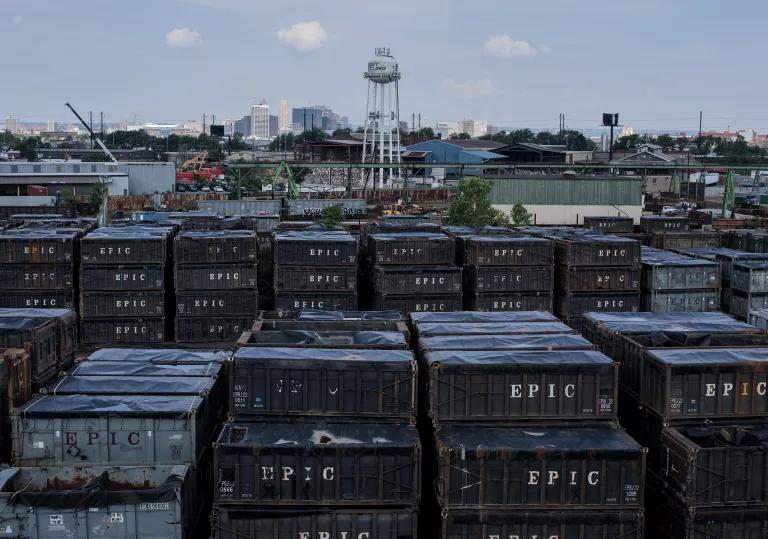
Containers stacked up in front of a railyard that backs onto a new building site on Hyatt Avenue in the Ironbound
Ashley Gilbertson/VII/Redux
“When, for the first time, you have to take your kid to the hospital because they can’t breathe, your life changes,” says Miles, who is the environmental justice manager for the Ironbound Community Corporation (ICC), a grassroots group dedicated to uplifting the community. “After all that, my priorities changed.”
“First it became about getting out of here, but then I realized there really weren’t many places I could go where I wasn’t going to have to face social justice issues,” adds Miles. “We know that the color of your skin and your income pretty much determine how close you’re going to live to pollution. That wasn’t changing, and so I decided that this was the place that I needed to make a stand for my kid and for other kids.”
The Fight for Clean Air
In spite of its toxic legacy, the Ironbound is a thriving working-class community. That’s evident at any one of ICC’s four community centers, like the one on Cortland Street, which offers after-school programs for kids of all ages, a community garden with chickens to tend, and various family-oriented social services.
Maria Lopez-Nuñez is ICC’s director of environmental justice and community development. In a community where two out of every three residents came to the United States as immigrants, and one out of every four lives in poverty, she notes, “we don’t have the luxury of fighting one issue. We have a holistic vision, making sure that we’re taking care of people on all levels: access to healthy food, clean air and water, safe and dignified jobs, a place to live. That means we have to respond to anything that emerges.”
Lopez-Nuñez’s passion for her cause was clear on a snowy day this past winter when she and other ICC staff led local middle school students in a protest of the Covanta trash incinerator—a blight on their community since 1990. The facility burns 2,800 tons of trash each day—primarily waste trucked in from New York City. That day, students chanted demands for clean air through bullhorns and carried signs with slogans that read “Stop burning Newark” and “Be fair: Stop poisoning our air.” Many of the young activists have spent their entire lives breathing in the lead, dioxin, and other pollutants emitted by the incinerator.
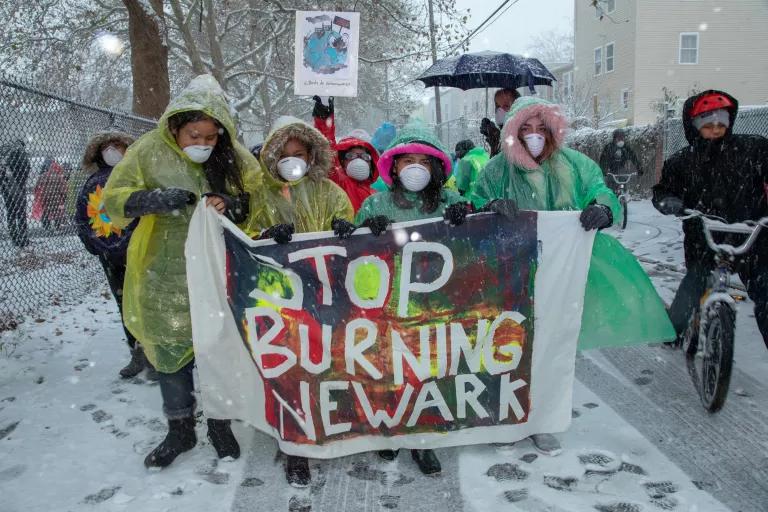
Children and their families protesting the Covanta trash incinerator in Newark, November 2018
Courtesy ICC
Challenging Covanta is just one of ICC’s decades-long campaigns to improve local air quality. Cleaning up Port Newark is another. There, the diesel emissions are almost palpable as tractor-trailer cabs line up along Port Jersey Boulevard, awaiting the delivery of freight from enormous container ships—some of which are about as long as the Empire State Building is tall. Each ship can carry thousands of large metal containers that are unloaded and attached to the trucks, which then fan out through the neighborhood, weaving through residential streets, clogging the highway, idling near the port.
Diesel exhaust isn’t just unsightly. Long-term exposure—like the chronic pollution experienced by residents and workers in the Ironbound—is linked to increased rates of asthma, cancers, cardiovascular disease, as well as neurological problems in children. In the United States, more than 20,000 individuals die prematurely every year from diesel pollution and the harmful particulate matter it contains.
In 2010, under pressure from community organizers and local officials, and with some support from the U.S. Environmental Protection Agency, the Port Authority of New York and New Jersey committed to banning trucks with engines made before 2007. But in 2016, when the price tag for the Port Authority’s truck-replacement program ballooned, shipping companies—who rely on independent truck operators to move their goods—refused to help pay the costs of meeting the new standards. At the same time, the Port Authority severely rolled back its rule—breaking its promise to clean up the pollution that continues to sicken Newark residents. Whereas the original rule would have cut 90 percent of truck emissions at the port by its first year of implementation in 2017, it will now take 15 years to do so, according to a 2017 study by the Coalition for Healthy Ports, which includes ICC and the truck drivers of the Teamsters union, among other groups.
“We’re pushing for a ban [on older trucks] like the one in California, for better truck routing and electrification—but we’re way behind,” Miles says, referencing ambitious programs at the Ports of Los Angeles and Long Beach. “We will never give up on helping the port to see that it needs to take a stronger stance on mitigating pollution.”
But the expanding port isn’t the only goods‑movement goliath bringing trucks to the area. There’s also the creeping growth in warehousing. Currently, Newark’s zoning laws do not distinguish between small‑scale warehouses and massive, 100,000-square-foot distribution centers. That means large-scale sites receive no additional environmental review, even though the size of these facilities can have a drastic impact on the number of trucks on city streets.
ICC, which turns 50 this year, is determined to amplify the voices of residents in advocating for progress on these issues. The group hosts community health fairs, encourages citizen scientists to monitor air pollution, and organizes truck counts. In one instance, ICC counted more than 2,000 trucks passing Ironbound schools or playgrounds in just two hours—an average of 16 trucks per minute.
Raising Awareness
One of ICC’s many public programs is a local environmental justice tour. Guided by the group’s experts, participants get a firsthand view of the Ironbound’s dizzying number of dirty facilities and the legacy of corporate greed and broken political promises that have stained the neighborhood. The tour—with all its sights, noises, and smells—is a lesson in cumulative environmental burdens, and Sara Imperiale, a senior attorney with NRDC’s Healthy People & Thriving Communities program, has brought legal interns from NRDC’s New York office to experience it. “It’s the kind of education a future lawyer, and anyone who purports to be an environmental expert, really needs,” she says. “It’s no coincidence that the region’s polluting industries are overwhelmingly sited here.”
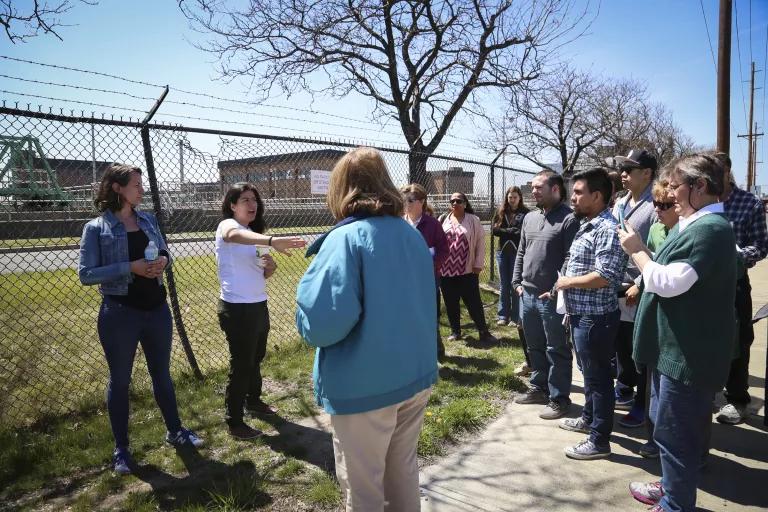
Maria Lopez-Nunez leading an EJ Tour of Ironbound’s dirtiest facilities
Ryan Genualdi
In the past few years, ICC and its allies have drummed up greater recognition of the Ironbound community’s environmental concerns. Science has been a critical tool for the group—currently, ICC is working with NRDC environmental justice and health science fellow Yukyan Lam to develop maps that assess how neighborhoods in the city compare in terms of pollution and its sources. The comparison also factors in socio-demographic characteristics that can make people more vulnerable to the effects of pollution, calculating a “cumulative impact” score for each census block group (an area with typically 600 to 3,000 inhabitants). It’s a technique NRDC has already used to raise the profile of vulnerable neighborhoods in Chicago, Lam notes, and to generate questions and insights. “For example,” she says, “it may show we need more precautions in an area that already carries a heavy environmental burden.” The maps are also intended to help community members tell the story of their lived experience in a way that resonates with local and state decision makers, adds Imperiale.
Local officials have indeed begun to respond to residents’ concerns regarding the health threats they face. For example, Newark’s new Master Plan includes sustainability and environmental justice goals, and the city is pioneering an Environmental Justice and Cumulative Impact Ordinance, which expands the review process for new development to consider negative impacts on heavily burdened areas.
“Newark is the only city that has something like this,” Lopez-Nuñez says. “I’m proud of this little city for taking that stand.”
The Ironbound Evolves
Ana Baptista is chair of the environmental policy and sustainability management program at the New School in New York and serves on ICC’s board. “Newark’s ordinance was an effort to move the community closer to having more say and more control over their own destiny,” she says. She also believes overburdened communities elsewhere can take inspiration from this effort as they advocate for similar legislation to address the pollution in their midst.
With support from the New School’s Tishman Environment and Design Center and NRDC, Baptista recently published a national review of environmental justice–related zoning and land-use policies. “I wrote the report that I wish I’d had years ago when we were advocating for these policies in Newark, especially when city lawyers were saying, ‘Who else has done this? We can’t do this,’ ” she says with a laugh.
Fresh off her research, Baptista reflects on the structural challenges still in play. “How do we start to build economic alternatives that are not as polluting? How do we start to reinvest in the neighborhoods in a way that doesn’t gentrify them and displace communities, but actually helps anchor them in place?”
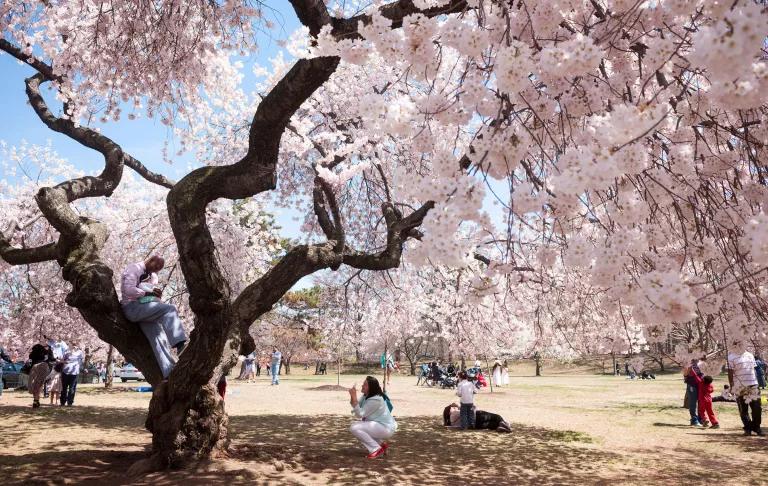
Families gathering for last year's Bloomfest, Newark
Richard Levine/Alamy
In fact, the residents of the Ironbound have made major strides in remaking their neighborhood’s image. They’ve helped turn it into an art and food destination and rallied support for the once unfathomable Newark Riverfront Park—another result of ICC’s longtime planning efforts.
“Too often in the history of urban revitalization, the people who get to reap the benefits aren’t the ones that had to live through all this industry and toxic pollution,” Lopez-Nuñez says. “In my vision for the Ironbound, everyone who wants to stay here can stay here in a tight-knit, sustainable, regenerative neighborhood.”
Miles echoes those feelings. “I can’t say I’ve ever talked to someone who really wanted to leave this neighborhood. Being rooted in place is definitely the number one thing. We just want our community to be healthy.”
This NRDC.org story is available for online republication by news media outlets or nonprofits under these conditions: The writer(s) must be credited with a byline; you must note prominently that the story was originally published by NRDC.org and link to the original; the story cannot be edited (beyond simple things such as grammar); you can’t resell the story in any form or grant republishing rights to other outlets; you can’t republish our material wholesale or automatically—you need to select stories individually; you can’t republish the photos or graphics on our site without specific permission; you should drop us a note to let us know when you’ve used one of our stories.

What Can We Do to Fix the Drinking Water Problem in America?
Environmental Justice in Chicago: It’s Been One Battle After Another
Fighting the Tide of Watered Down Justice
What Can We Do to Fix the Drinking Water Problem in America?
Environmental Justice in Chicago: It’s Been One Battle After Another
Fighting the Tide of Watered Down Justice
What Can We Do to Fix the Drinking Water Problem in America?
Environmental Justice in Chicago: It’s Been One Battle After Another
Fighting the Tide of Watered Down Justice
What Can We Do to Fix the Drinking Water Problem in America?
Environmental Justice in Chicago: It’s Been One Battle After Another